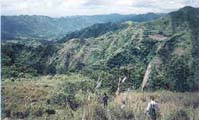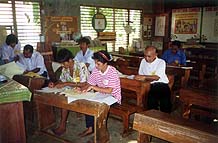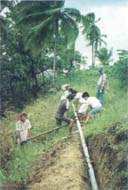
The following summarizes chronologically
the strategies and the essential activities from start of field implementation to system/
facility operation. It is important to note that the process is structured under three
major phases: the Formation, Development, and Consolidation of Organization.
Phase I - Formation of
Organization
It is in this phase that entry strategies
were planned and decided, actual beneficiaries and leaders were identified, and informal
community organization was formed.
Community Entry. A courtesy call by
the municipal level implementors to the local (municipal and barangay) officials
and oriented them on the project concept, features, history, stakeholder, community
organizing process, and capability-building program. The people who are going to be
involved in the project were also introduced to them.
As soon as the Community Organizer (CO) was
installed, the prospective beneficiaries were gathered and oriented on the proposed
project. Volunteers from the community were encouraged to enlist and participate in the
conduct of the profiling and spot mapping. It was the first Community Meeting held for the
project.
Conduct Community Profiling and Spot
Mapping. The CO and the community  volunteers started gathering primary and secondary information to enrich and
validate the project data. They were able to produce a consolidated community profile and
a reliable project site spot map. volunteers started gathering primary and secondary information to enrich and
validate the project data. They were able to produce a consolidated community profile and
a reliable project site spot map.
To further validate and enrich the gathered
data, and to solicit thoughts and ideas on the project, a second community meeting was
set. The CO invited the local leaders (farmer, church, civic, business, school, elders,
youth) or the key informants for the meeting. The objective was to present the community
profile and the spot map. The meeting had helped determine the potential leaders for core
membership. Potential leaders are usually those that are well liked and respected, know
local conditions and needs, successful in their field of activity, and willing to be of
service in improving conditions in the community.
Formation of Core Group. The
importance of the core group (CG) rests on the need to bring together local leaders and
community members to exchange and share knowledge, insights, skills, and strategies
towards the realization of a community water and sanitation project. It lays the
foundation of a strong RWSA.
The long listed potential core group
members were invited in the third Community Meeting set by the CO. In the meeting, the
criteria for selection of core group was developed, members were selected, committees were
created, and the respective tasks and responsibilities were formulated.
Requisition of Technical Assistance.
Various offices (i.e., Department of Public Works and Highways, PPDO) were visited by the
CO and the Chairman of the CG Committee on Coordination and Manpower to request technical
assistance in the water site selection and other technical data gathering. Ocular survey
was conducted, potential water sources were identified, and various technical information
were gathered.
Presentation of Feasibility Study
Initial Findings. The survey initial findings are presented by the technical team in
the first Core Group Meeting to solicit reactions to the presented tentative
recommendations for technology options. Confirmation of the recommendations and decisions
were made by the Core Group during a series of meetings.
Training on Human Resource Development.
The core group members and barangay officials were given a capability enhancement
training to give them the necessary knowledge, skills and attitude on value formation,
team building, and leadership.
Presentation of Draft Technical Design.
In the fourth Community Meeting, the following information were presented to the
community: a) role of the technical team, b) contents of the water system layout and plan,
c) the design specifications, plans and drawings in layman’s terms, and d) schedule
of works, bill of materials and cost estimates. The community was made to comment, and
ideas and preferences were solicited, thus data used in the designing were further
validated.
Sites were visited by the core group and
the community, with the technical team, for field validation of locations of proposed
major facilities.
Facilitation on Legal Works and
Documents. The CO, CG Committee on Documentation, and the Barangay Council joined
hands in the preparation and/or securing legal documents required in the implementation of
water and sanitation project, such as building permit from the local government unit,
rights-of-way and/or deeds-of-donation from the private land owners, certificate of water
quality from the Department of Health, water right and permit from National Water
Resources Board, among others.
Training on Sanitation and Hygiene
Education. A third capability enhancement training was conducted for the Core Group,
the Barangay Council, and the community. The Rural Health Unit Officer, Rural
Sanitary Inspector, and the Barangay health workers were among the invited resource
speakers. This was to give the entire community the necessary knowledge, skills, and
attitude on proper sanitation and hygiene, giving emphasis on excreta disposal technology
options, and personal, household and community hygiene.
Presentation of Final Technical Water
System Design. The final technical water system design, with its implementation design
and schedule, was presented by the Technical Team during a meeting with the Core Group.
The objective was to obtain the approval of the project beneficiaries, and the agreement
from community on their final counterpart (kinds, quality and time of availability). Site
visit was again made by the Core Group with the Technical Team to familiarize and stake
out final locations of proposed major facility components and tapstands.
Formation of Tapstand Groups. Homes
of possible project beneficiaries were visited by the CO and the CG Committee on Education
and Recruitment to conduct membership campaign and facilitate listing of formal membership
by tapstand.
To confirm its membership, the first
Tapstand Meeting was set. The tapstand members, after being oriented on the importance of
tapstand groupings, grouped and selected their respective representative or leader. Points
were discussed, and under the facilitation of the new leaders and the CO, tapstand
policies were formulated.
Phase II - Development of
Organization
Within six months, the formation of the
organization was formalized, and more trainings (formal and informal) were conducted for
the Core Group, Tapstand leaders and the Barangay Council. It is important to note
the participation of the organization in the technical activities - design validation,
pre-construction conference, and in the construction stage of the project. It should also
be noted that the Community Organizer facilitated all the activities in this phase.
Training on System Management and
Operation, and Organizational Management. To familiarize the Core Group, Tapstand leaders, and the Barangay
Council with the different types of water systems/facilities and expose them to
different types of system management and operations, visits to existing sustainable water
and sanitation projects with self-reliant associations were arranged. During each visit,
they learned and discussed system management, policies and procedures, and problems. The
Core Group was encouraged to establish a good relationship with these self-reliant
associations for support. Group, Tapstand leaders, and the Barangay
Council with the different types of water systems/facilities and expose them to
different types of system management and operations, visits to existing sustainable water
and sanitation projects with self-reliant associations were arranged. During each visit,
they learned and discussed system management, policies and procedures, and problems. The
Core Group was encouraged to establish a good relationship with these self-reliant
associations for support.
Another capability enhancement training was
conducted for the Core Group members, Tapstand leaders, and Barangay Council to
develop their managerial and facilitation skills. Management policies, operation
procedures, constitution and by-laws, and duties and responsibilities of officers were
formulated after the training.
Pre-Construction Conference. The
Technical Team presented to the Core Group, Barangay Council representatives, and
the construction crew the water system engineering drawings. The team briefed the
construction crew on the construction activities and their sequence, duration, and
manpower and material requirements. The CG Committee on Monitoring, Evaluation and Control
was briefed on material dispensing. Procedures for purchasing and release of materials
were developed and installed. Other concerned committees were also mobilized.
Execution of Preliminary Construction
Activities. The construction of the water system facilities commenced. Its activities
include: a) the water source site clearing, b) excavation of structure foundation, c)
pipeline trenching, and d) hauling local materials, such as sand, gravel, stones and
lumber.
The Core Group Chairman called on a meeting
to develop an action plan to the physical system construction activities. Together with
the Technical Team, action plans were developed on all activities related to construction,
monitoring and documentation of construction, progress reporting and evaluation,
mobilization of core group committees and community work force.
Facility Construction Monitoring and
Evaluation. The Core Group conducted regular meetings and field works to monitor and
document the construction activities, to evaluate its progress, and to develop a plan of
action (controlling the release of construction materials, scheduling of dispatching of
manpower for different work places).
Formulation and Ratification of
Management Policies, Operating Procedures, and Constitution and By-Laws. The Core
Group met the Tapstand leaders/representatives to present and discuss the formulated set
of policies per tapstand, and decide which policies are for adoption and incorporation to
the association policies and procedures. Consequently, the Tapstand
leaders/representatives called in the members for a meeting to finalize and approve the
revised formulated tapstand policies per group. The approved sets of Tapstand policies
were then submitted to the Core Group for final adoption/consideration into the overall
system management policies and operating procedures.
A second meeting between the Core Group and
the Tapstand leaders/representatives was set to identify practical management policies and
operating procedures, and discuss the ready-made waterworks management constitution and
by-laws. The draft policies, procedures, and constitution and by-laws were distributed to
tapstand leaders for discussion to their members.
Finally, a Community Meeting was called to
discuss the draft management policies and operating procedures, and the constitution and
its by-laws. With the Core Group Chairman and the CO facilitating, the draft policies,
procedures, and constitution and by-laws were approved. The management officers were then
voted and selected.
Phase III - Consolidation
With the completion of the physical
construction of major facilities, test run and adjustment for operation, repair and
maintenance were done in this phase. As the Association increased its self-management and
problem-solving capacities, the Community Organizer gradually exited, and the
Association’s vision and future directions started to take shape.
Unlike the traditional organization, the
election of officers in this process came in last. As soon as the Core Group was
organized, a chairman was appointed to chair all the discussions and preside in all the
meetings. This eliminated biases in the formulation of policies, constitution and by-laws.
 Facility/System
Test Run and Operational Demonstration. The community participated in inspecting the
newly constructed water system, and observed the test run/demonstration on the operation
of facility. Also present as participants were the newly appointed/hired technical
management staff. The field trip served as their hands-on training, and oriented them on
the routine operations of the water system. Facility/System
Test Run and Operational Demonstration. The community participated in inspecting the
newly constructed water system, and observed the test run/demonstration on the operation
of facility. Also present as participants were the newly appointed/hired technical
management staff. The field trip served as their hands-on training, and oriented them on
the routine operations of the water system.
First water samples from the facility were
collected for testing at the Department of Health for its potability.
Turnover and Blessing of Water System
Facilities. A program was set to celebrate the blessing of the new water system, and
to swear-in the elected officers or Board of Directors. Highlighting the event was the
turn over of water system facilities to the organization.
The newly installed Board of Directors, the
Technical Management Staff, the Technical Team and the CO met to develop an action plan
relative to the management and operation of the water system.
The association was registered in the Local
Water Utility Authority. Once registered, applications for accreditation with the
respective local government units were also processed.
Trainings on Operational and Financial
Management. The Technical Management Staff and the Board of Directors were given two
more trainings to give them the necessary knowledge, skills, and attitude in the
operational and financial management of the water system.
Commencement of the Facility Operation
and Management. Now equipped with all the knowledge, skills, and attitude that they
acquired during the process, the technical management staff and the Board of Directors
started the daily operation and management of the water system.
The CO and the Technical Team also assisted
the Association in facilitating the formulation of organizational, managerial, and
operational monitoring and evaluation system of the association shortly before project
completion and eventual pull out.
basic info
| initiative
| strategy
| critical factors
| other links
| home
|

